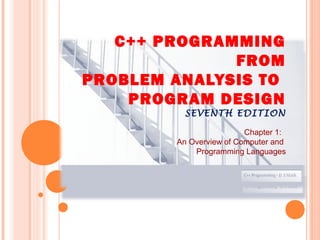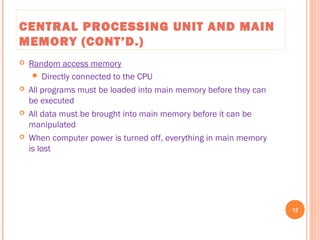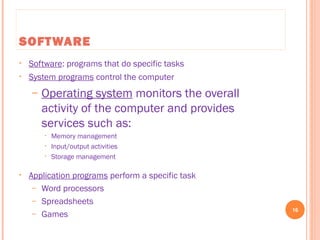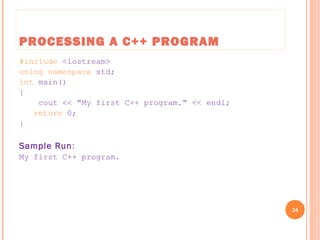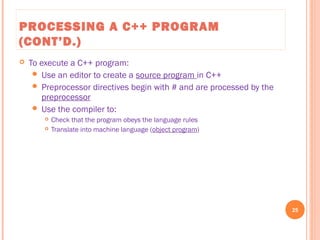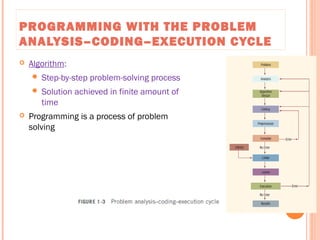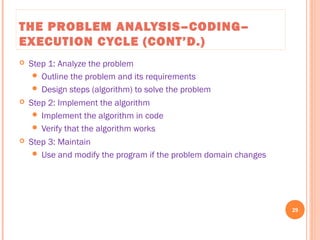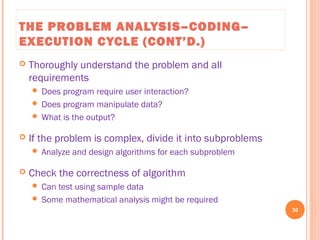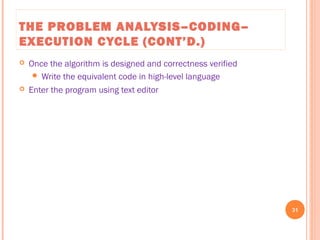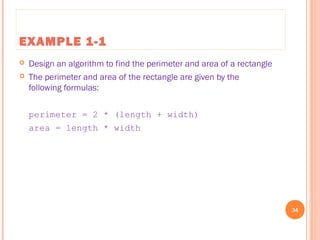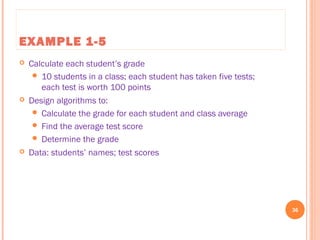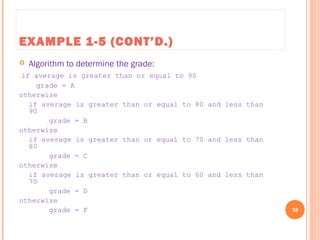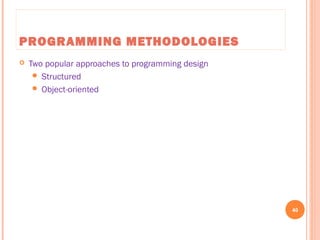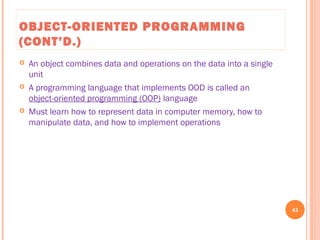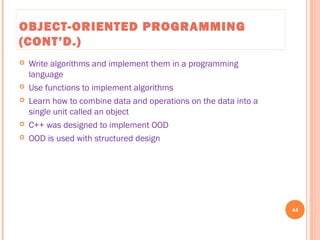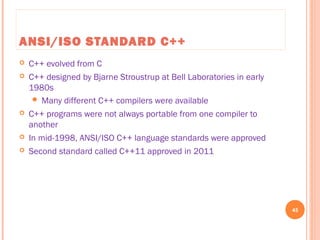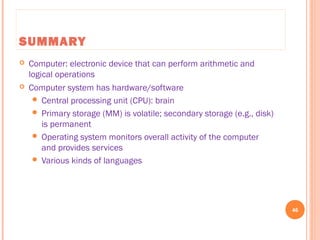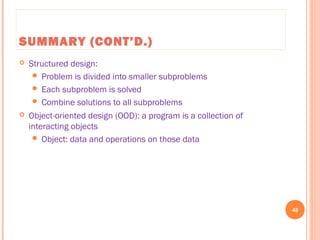ch01_an overview of computers and programming languages
- 1. C++ PROGRAMMING FROM PROBLEM ANALYSIS TO PROGRAM DESIGN SEVENTH EDITION Chapter 1: An Overview of Computer and Programming Languages
- 2. OBJECTIVES In this chapter, you will: Learn about different types of computers Explore the hardware and software components of a computer system Learn about the language of a computer Learn about the evolution of programming languages Examine high-level programming languages 2 C++Programming:FromProblemAnalysis toProgramDesign,SeventhEdition
- 3. OBJECTIVES (CONT’D.) Discover what a compiler is and what it does Examine a C++ program Explore how a C++ program is processed Learn what an algorithm is and explore problem-solving techniques Become aware of structured design and object-oriented design programming methodologies Become aware of Standard C++, ANSI/ISO Standard C++, and C++11 3 C++ Programming: From Problem Analysis to Program Design, Seventh Edition
- 4. INTRODUCTION Without software, the computer is useless Software is developed with programming languages C++ is a programming language C++ suited for a wide variety of programming tasks 4 C++ Programming: From Problem Analysis to Program Design, Seventh Edition
- 5. A BRIEF OVERVIEW OF THE HISTORY OF COMPUTERS Early calculation devices Abacus, Pascaline Leibniz device Jacquard’s weaving looms Babbage machines: difference and analytic engines Hollerith machine 5 C++ Programming: From Problem Analysis to Program Design, Seventh Edition
- 6. A BRIEF OVERVIEW OF THE HISTORY OF COMPUTERS (CONT’D.) Early computer-like machines Mark I ENIAC Von Neumann architecture UNIVAC Transistors and microprocessors 6 C++ Programming: From Problem Analysis to Program Design, Seventh Edition
- 7. A BRIEF OVERVIEW OF THE HISTORY OF COMPUTERS (CONT’D.) Categories of computers Mainframe computers Midsize computers Micro computers (personal computers) 7 C++ Programming: From Problem Analysis to Program Design, Seventh Edition
- 8. ELEMENTS OF A COMPUTER SYSTEM Hardware CPU Main memory Secondary storage Input/Output devices Software 8 C++ Programming: From Problem Analysis to Program Design, Seventh Edition
- 9. HARDWARE CPU Main memory: RAM Input/output devices Secondary storage 9 C++ Programming: From Problem Analysis to Program Design, Seventh Edition
- 10. CENTRAL PROCESSING UNIT AND MAIN MEMORY Central processing unit Brain of the computer Most expensive piece of hardware Carries out arithmetic and logical operations 10 C++ Programming: From Problem Analysis to Program Design, Seventh Edition
- 11. CENTRAL PROCESSING UNIT AND MAIN MEMORY (CONT’D.) 11 C++ Programming: From Problem Analysis to Program Design, Seventh Edition
- 12. CENTRAL PROCESSING UNIT AND MAIN MEMORY (CONT’D.) Random access memory Directly connected to the CPU All programs must be loaded into main memory before they can be executed All data must be brought into main memory before it can be manipulated When computer power is turned off, everything in main memory is lost 12 C++ Programming: From Problem Analysis to Program Design, Seventh Edition
- 13. CENTRAL PROCESSING UNIT AND MAIN MEMORY (CONT’D.) Main memory is an ordered sequence of memory cells Each cell has a unique location in main memory, called the address of the cell Each cell can contain either a programming instruction or data 13 C++ Programming: From Problem Analysis to Program Design, Seventh Edition
- 14. SECONDARY STORAGE Secondary storage: device that stores information permanently Examples of secondary storage: Hard disks Flash drives Floppy disks Zip disks CD-ROMs Tapes 14 C++ Programming: From Problem Analysis to Program Design, Seventh Edition
- 15. INPUT/OUTPUT DEVICES Input devices feed data and programs into computers Keyboard Mouse Secondary storage Output devices display results Monitor Printer Secondary storage 15 C++ Programming: From Problem Analysis to Program Design, Seventh Edition
- 16. SOFTWARE • Software: programs that do specific tasks • System programs control the computer – Operating system monitors the overall activity of the computer and provides services such as: • Memory management • Input/output activities • Storage management • Application programs perform a specific task – Word processors – Spreadsheets – Games 16 C++ Programming: From Problem Analysis to Program Design, Seventh Edition
- 17. THE LANGUAGE OF A COMPUTER Analog signals: continuous wave forms Digital signals: sequences of 0s and 1s Machine language: language of a computer; a sequence of 0s and 1s Binary digit (bit): the digit 0 or 1 Binary code (binary number): a sequence of 0s and 1s 17 C++ Programming: From Problem Analysis to Program Design, Seventh Edition
- 18. THE LANGUAGE OF A COMPUTER (CONT’D.) Byte: A sequence of eight bits Kilobyte (KB): 210 bytes = 1024 bytes ASCII (American Standard Code for Information Interchange) 128 characters A is encoded as 1000001 (66th character) 3 is encoded as 0110011 18 C++ Programming: From Problem Analysis to Program Design, Seventh Edition
- 19. THE LANGUAGE OF A COMPUTER (CONT’D.) 19 C++ Programming: From Problem Analysis to Program Design, Seventh Edition
- 20. THE LANGUAGE OF A COMPUTER (CONT’D.) EBCDIC Used by IBM 256 characters Unicode 65536 characters Two bytes are needed to store a character 20 C++ Programming: From Problem Analysis to Program Design, Seventh Edition
- 21. THE EVOLUTION OF PROGRAMMING LANGUAGES Early computers were programmed in machine language To calculate wages = rate * hours in machine language: 100100 010001 //Load 100110 010010 //Multiply 100010 010011 //Store 21 C++ Programming: From Problem Analysis to Program Design, Seventh Edition
- 22. THE EVOLUTION OF PROGRAMMING LANGUAGES (CONT’D.) Assembly language instructions are mnemonic Assembler: translates a program written in assembly language into machine language Using assembly language instructions, wages = rate • hours can be written as: LOAD rate MULT hour STOR wages 22 C++ Programming: From Problem Analysis to Program Design, Seventh Edition
- 23. THE EVOLUTION OF PROGRAMMING LANGUAGES (CONT’D.) High-level languages include Basic, FORTRAN, COBOL, Pascal, C, C++, C#, and Java Compiler: translates a program written in a high-level language into machine language The equation wages = rate • hours can be written in C++ as: wages = rate * hours; 23 C++ Programming: From Problem Analysis to Program Design, Seventh Edition
- 24. PROCESSING A C++ PROGRAM #include <iostream> using namespace std; int main() { cout << "My first C++ program." << endl; return 0; } Sample Run: My first C++ program. 24 C++ Programming: From Problem Analysis to Program Design, Seventh Edition
- 25. PROCESSING A C++ PROGRAM (CONT’D.) To execute a C++ program: Use an editor to create a source program in C++ Preprocessor directives begin with # and are processed by the preprocessor Use the compiler to: Check that the program obeys the language rules Translate into machine language (object program) 25 C++ Programming: From Problem Analysis to Program Design, Seventh Edition
- 26. PROCESSING A C++ PROGRAM (CONT’D.) To execute a C++ program (cont'd.): Linker: Combines object program with other programs provided by the SDK to create executable code Library: contains prewritten code you can use Loader: Loads executable program into main memory The last step is to execute the program Some IDEs do all this with a Build or Rebuild command 26 C++ Programming: From Problem Analysis to Program Design, Seventh Edition
- 27. PROCESSING A C++ PROGRAM (CONT’D.) 27 C++ Programming: From Problem Analysis to Program Design, Seventh Edition
- 28. PROGRAMMING WITH THE PROBLEM ANALYSIS–CODING–EXECUTION CYCLE Algorithm: Step-by-step problem-solving process Solution achieved in finite amount of time Programming is a process of problem solving 28 C++ Programming: From Problem Analysis to Program Design, Seventh Edition
- 29. THE PROBLEM ANALYSIS–CODING– EXECUTION CYCLE (CONT’D.) Step 1: Analyze the problem Outline the problem and its requirements Design steps (algorithm) to solve the problem Step 2: Implement the algorithm Implement the algorithm in code Verify that the algorithm works Step 3: Maintain Use and modify the program if the problem domain changes 29 C++ Programming: From Problem Analysis to Program Design, Seventh Edition
- 30. THE PROBLEM ANALYSIS–CODING– EXECUTION CYCLE (CONT’D.) Thoroughly understand the problem and all requirements Does program require user interaction? Does program manipulate data? What is the output? If the problem is complex, divide it into subproblems Analyze and design algorithms for each subproblem Check the correctness of algorithm Can test using sample data Some mathematical analysis might be required 30 C++ Programming: From Problem Analysis to Program Design, Seventh Edition
- 31. THE PROBLEM ANALYSIS–CODING– EXECUTION CYCLE (CONT’D.) Once the algorithm is designed and correctness verified Write the equivalent code in high-level language Enter the program using text editor 31 C++ Programming: From Problem Analysis to Program Design, Seventh Edition
- 32. THE PROBLEM ANALYSIS–CODING– EXECUTION CYCLE (CONT’D.) Run code through compiler If compiler generates errors Look at code and remove errors Run code again through compiler If there are no syntax errors Compiler generates equivalent machine code Linker links machine code with system resources 32 C++ Programming: From Problem Analysis to Program Design, Seventh Edition
- 33. THE PROBLEM ANALYSIS–CODING– EXECUTION CYCLE (CONT’D.) Once compiled and linked, loader can place program into main memory for execution The final step is to execute the program Compiler guarantees that the program follows the rules of the language Does not guarantee that the program will run correctly 33 C++ Programming: From Problem Analysis to Program Design, Seventh Edition
- 34. EXAMPLE 1-1 Design an algorithm to find the perimeter and area of a rectangle The perimeter and area of the rectangle are given by the following formulas: perimeter = 2 * (length + width) area = length * width 34 C++ Programming: From Problem Analysis to Program Design, Seventh Edition
- 35. EXAMPLE 1-1 (CONT’D.) Algorithm: Get length of the rectangle Get width of the rectangle Find the perimeter using the following equation: perimeter = 2 * (length + width) Find the area using the following equation: area = length * width 35 C++ Programming: From Problem Analysis to Program Design, Seventh Edition
- 36. EXAMPLE 1-5 Calculate each student’s grade 10 students in a class; each student has taken five tests; each test is worth 100 points Design algorithms to: Calculate the grade for each student and class average Find the average test score Determine the grade Data: students’ names; test scores 36 C++ Programming: From Problem Analysis to Program Design, Seventh Edition
- 37. EXAMPLE 1-5 (CONT’D.) Algorithm to determine the average test score: Get the five test scores Add the five test scores Suppose sum stands for the sum of the test scores Suppose average stands for the average test score: average = sum / 5; 37 C++ Programming: From Problem Analysis to Program Design, Seventh Edition
- 38. EXAMPLE 1-5 (CONT’D.) Algorithm to determine the grade: if average is greater than or equal to 90 grade = A otherwise if average is greater than or equal to 80 and less than 90 grade = B otherwise if average is greater than or equal to 70 and less than 80 grade = C otherwise if average is greater than or equal to 60 and less than 70 grade = D otherwise grade = F 38 C++ Programming: From Problem Analysis to Program Design, Seventh Edition
- 39. EXAMPLE 1-5 (CONT’D.) Main algorithm is as follows: totalAverage = 0; Repeat the following for each student: Get student’s name Use the algorithm to find the average test score Use the algorithm to find the grade Update totalAverage by adding current student’s average test score Determine the class average as follows: classAverage = totalAverage / 10 39 C++ Programming: From Problem Analysis to Program Design, Seventh Edition
- 40. PROGRAMMING METHODOLOGIES Two popular approaches to programming design Structured Object-oriented 40 C++ Programming: From Problem Analysis to Program Design, Seventh Edition
- 41. STRUCTURED PROGRAMMING Structured design: Dividing a problem into smaller subproblems Structured programming: Implementing a structured design The structured design approach is also called: Top-down (or bottom-up) design Stepwise refinement Modular programming 41 C++ Programming: From Problem Analysis to Program Design, Seventh Edition
- 42. OBJECT-ORIENTED PROGRAMMING Object-oriented design (OOD) Identify components called objects Determine how objects interact with each other Specify relevant data and possible operations to be performed on that data Each object consists of data and operations on that data 42 C++ Programming: From Problem Analysis to Program Design, Seventh Edition
- 43. OBJECT-ORIENTED PROGRAMMING (CONT’D.) An object combines data and operations on the data into a single unit A programming language that implements OOD is called an object-oriented programming (OOP) language Must learn how to represent data in computer memory, how to manipulate data, and how to implement operations 43 C++ Programming: From Problem Analysis to Program Design, Seventh Edition
- 44. OBJECT-ORIENTED PROGRAMMING (CONT’D.) Write algorithms and implement them in a programming language Use functions to implement algorithms Learn how to combine data and operations on the data into a single unit called an object C++ was designed to implement OOD OOD is used with structured design 44 C++ Programming: From Problem Analysis to Program Design, Seventh Edition
- 45. ANSI/ISO STANDARD C++ C++ evolved from C C++ designed by Bjarne Stroustrup at Bell Laboratories in early 1980s Many different C++ compilers were available C++ programs were not always portable from one compiler to another In mid-1998, ANSI/ISO C++ language standards were approved Second standard called C++11 approved in 2011 45 C++ Programming: From Problem Analysis to Program Design, Seventh Edition
- 46. SUMMARY Computer: electronic device that can perform arithmetic and logical operations Computer system has hardware/software Central processing unit (CPU): brain Primary storage (MM) is volatile; secondary storage (e.g., disk) is permanent Operating system monitors overall activity of the computer and provides services Various kinds of languages 46 C++ Programming: From Problem Analysis to Program Design, Seventh Edition
- 47. SUMMARY (CONT’D.) Compiler: translates high-level language into machine code Algorithm: step-by-step problem-solving process; solution in finite amount of time Problem-solving process has three steps: Analyze problem and design an algorithm Implement the algorithm in code Maintain the program 47 C++ Programming: From Problem Analysis to Program Design, Seventh Edition
- 48. SUMMARY (CONT’D.) Structured design: Problem is divided into smaller subproblems Each subproblem is solved Combine solutions to all subproblems Object-oriented design (OOD): a program is a collection of interacting objects Object: data and operations on those data 48 C++ Programming: From Problem Analysis to Program Design, Seventh Edition
